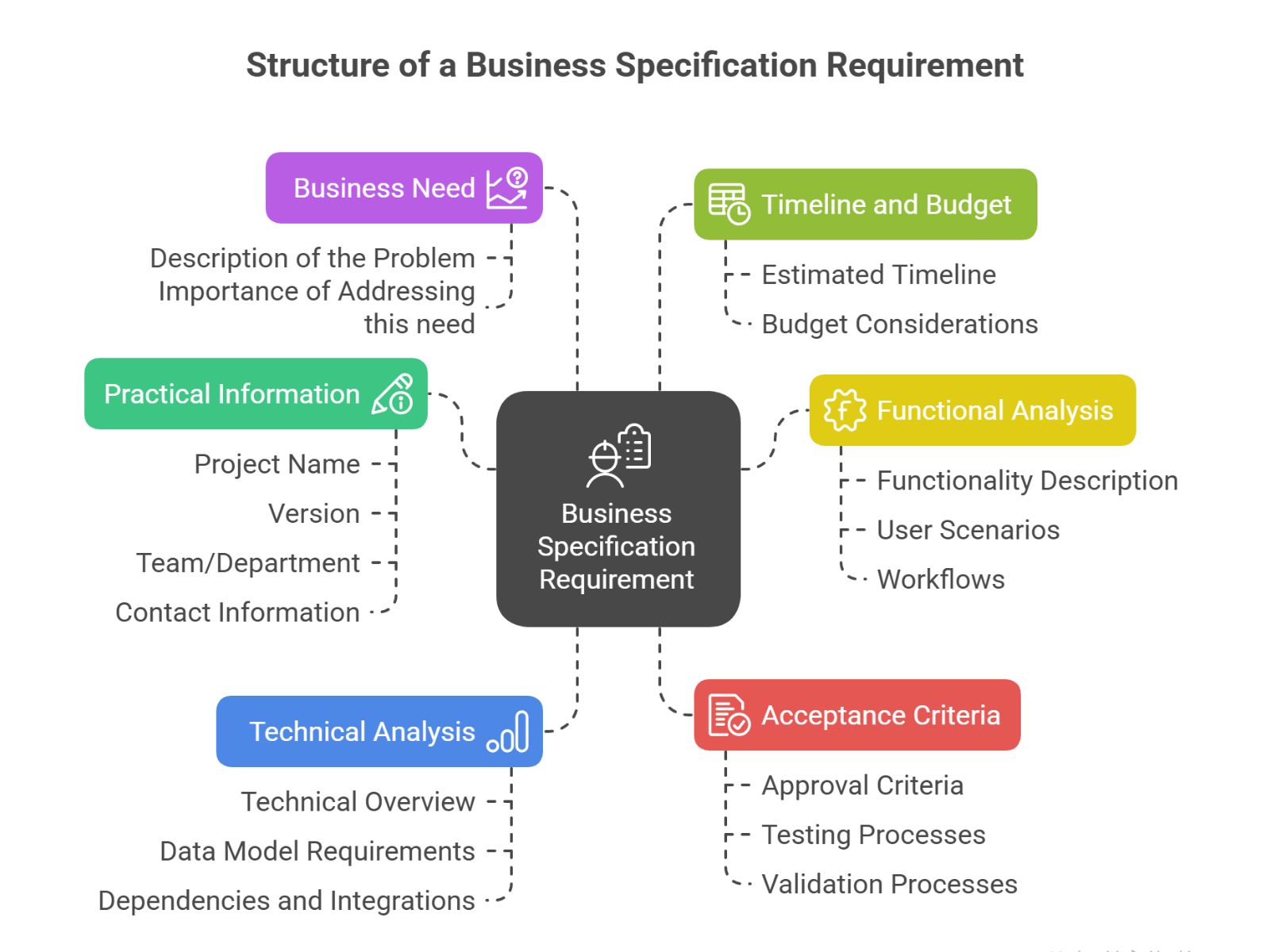Understanding Business Specification Requirements
Creating a clear and comprehensive business specification requirement is essential for ensuring that all stakeholders understand the project goals and expectations. This post will guide you through the structure of a well-written business specification requirement and provide a template that you can use to create your own.
Structure of a Business Specification Requirement
A business specification requirement typically includes the following sections:
- Practical Information
- Project Name
- Version
- Team/Department
- Contact Information
-
Business Need
- Description of the problem or opportunity.
- Importance of addressing this need.
-
Functional Analysis
- Detailed description of the functionality required.
- User scenarios and workflows.
-
Technical Analysis
- Overview of the technical aspects.
- Data model requirements.
- Dependencies and integrations.
-
Acceptance Criteria
- Criteria that must be met for the project to be approved.
- Testing and validation processes.
-
Timeline and Budget
- Estimated timeline for completion.
- Budget considerations.
Template for Writing a Business Specification Requirement
Practical Information
- Project Name: [Enter Project Name]
- Version: [Enter Version]
- Team/Department: [Enter Team/Department]
- Contact Information: [Enter Contact Information]
Business Need
Describe the business need or problem that this project addresses. Explain why it is important to address this need.
Functional Analysis
Provide a detailed functional analysis including user scenarios, workflows, and how the solution will work in practice.
Scenario to be
- [Step 1]
- [Step 2]
- [Step 3]
- [Step 4]
Technical Analysis
Outline the technical aspects of the project including data models, integrations, and any specific technologies that will be used.
Acceptance Criteria
List the criteria that must be met for the project to be considered successful, along with testing processes.
Timeline and Budget
Provide an estimated timeline for completing the project along with budget considerations.
Example of a Business Specification Requirement
Practical Information
- Project Name: Employee Onboarding System Development
- Version: 1.0
- Team/Department: HR Technology Team
- Contact Information: jane.doe@mycompany.com
Business Need
The organization requires an Employee Onboarding System to streamline the process of integrating new hires into the company. The current manual process is time-consuming and prone to errors, resulting in inconsistent onboarding experiences for new employees.
Functional Analysis
The Employee Onboarding System should include the following functionalities:
Scenario to be
- New hires can create their profiles and submit necessary documentation.
- HR personnel can track onboarding progress and send reminders for pending tasks.
- A dashboard provides insights on onboarding metrics and compliance.
- New hires receive automated welcome emails with essential onboarding information.
Technical Analysis
The system will be built using a cloud-based platform (e.g., AWS) with a React front end and a Python-based API for backend services. A relational database (e.g., MySQL) will be used to manage employee data and documentation.
Acceptance Criteria
- The system must have secure login features for both new hires and HR personnel.
- User profiles must be editable and securely stored.
- The onboarding process should have automated reminders for both HR and new hires.
- The dashboard must visibly display onboarding metrics in real-time.
Timeline and Budget
The estimated timeline for this project is four months, with a budget of $30,000 allocated for development, testing, and deployment.
By following this template and example, you can create your own business specification requirement that is clear, structured, and effective in communicating your project’s goals and expectations. Happy writing!



